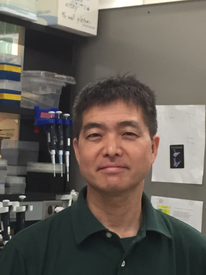
As neurosurgical director of the University of Minnesota Medical School’s Center for Skull Base and Pituitary Surgery, Andrew Venteicher has seen firsthand the tragic toll of chordoma, a rare form of bone cancer that attacks the skull and spinal column. Options for treating this complicated cancer are limited by a lack of understanding of how it arises. But a new interdisciplinary research collaboration between Venteicher and Yasuhiko Kawakami, associate professor in the Department of Genetics, Cell Biology, and Development, and colleagues, aims to shed light on the mechanism behind the disease—and so open the door to new and more effective treatment and cure.
Most cancers are associated with genetic mutations – changes in the DNA sequence. However, chordoma develops in most patients despite an absence of genetic mutation, leading researchers to suspect that the underlying cause may be epigenetic. These epigenetic changes may drive aberrant gene expression to cause chordoma development.
From previous studies, researchers know that chordoma is associated with the unregulated activation of the transcription factor gene, TBXT. The TBXT gene is typically active in the embryo in a specific cell population, called the notochord, but shuts down in mature cells. Might understanding how TBXT behaves during embryonic development shed light on how it becomes aberrantly activated in mature tissue to cause tumor growth – and therefore elucidate ways to stop it?
To answer that question, Venteicher reached out to Kawakami. Kawakami conducts basic science research on development in animal models—including how the mouse equivalent of TBXT turns on and off as the embryo develops. Kawakami’s expertise, combined with Venteicher’s clinical familiarity with chordoma and research proficiency in gene expression at the cellular level, could be just what is needed to crack the code.
The two applied for and were awarded a University of Minnesota MN Futures grant to search for an answer together. Also on the team is neurosurgery assistant professor Tomoyuki Koga, who is providing expertise in engineering cells for cancer research. Michael Gearhart, a GCD research assistant professor and an informatics expert with experience in developmental biology, will guide experimental design and analysis.
“By collaborating we can complement each other’s expertise,” Kawakami says. “That’s the great part.”
Over the two-year course of the MN Futures grant, the researchers will use mouse models to take a close look at chordoma. They will test their hypothesis that the unregulated TBXT gene expression underlying chordoma is caused by molecular changes in non-coding DNA elements known as enhancers that direct the temporal and spatial expression of TBXT. They will also identify the target genes that the TBXT transcription factor controls, and then boost or suppress expression of the targeted genes to see if a tumor develops. A clearer picture of the mechanism behind chordoma development is critical to formulate strategies to nipping it in the bud.
“If you want to develop a cure or treatment, you really need to understand what’s happening behind what you’re seeing,” Kawakami says. “In the best-case scenario, we will obtain strong data with which we can continue exploring these questions with extramural funding to find potential therapeutic targets.”
— Mary Hoff